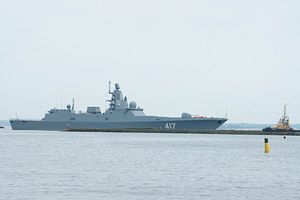The Admiral Gorshkov, lead ship of a new class of multirole blue-water warships, the Admiral Gorshkov-class (Project 22350) guided missile frigates, is expected to be delivered to the Russian Navy by November 2017 following years of delay in one of Russia’s most ambitious surface warship construction programs.
According to the chief of the Russian Navy’s shipbuilding department, Vladimir Tryapichnikov, three ships will be commissioned in the last weeks of 2017. “The Admiral Gorshkov, the Ivan Khurs, and the logistic ship The Elbrus are to be commissioned in November,” Tryapichnikov told TASS news agency on May 16.
The Admiral Gorshkov, with a total displacement of around 4,500 tons the largest surface warship built by Russia since the collapse of the Soviet Union, has been in construction for over 10 years. The ambitious shipbuilding project has been hampered by major problems, as I outlined previously (See: “Russia’s Navy to Field 2 New Guided Missile Warships by 2020”):
The Admiral Gorshkov-class program, kicked off in the early 2000s, has faced multiple delays in the last decade. The lead vessel of the class was laid down in 2006, launched in 2010, and has been undergoing builder sea trials since November 2014. It was expected to be handed over to the Russian Navy by November 2016, but technical difficulties with some of the ship’s weapons systems prevented that from happening. (The Russian Navy expects the lead ship of the class to be delivered to the Russian Navy for testing this July.)
Deputy Prime Minister Dmitry Rogozin recently told Russian media that the Navy will stick to the July testing schedule. The new guided missile frigate is a multirole warship designed for anti-air, anti-surface, and anti-submarine warfare. The ship’s air defense system — the Polimut Redut air defense missile system (Russia’s answer to the U.S. Navy’s Aegis combat system) — in particular has been suffering serious performance and compatibility problems. There are no indications that this has been resolved.
Next to the Polimut Redut air defense missile system, the ship is armed with the Kalibr supersonic cruise missile available in land-attack, anti-ship, and anti-submarine variants. (The Kalibr is also nuclear-capable.) In addition, the stealth frigate hosts the P-800 Oniks over-the-horizon supersonic anti-ship missile with an approximate maximum range of 600 kilometers. Both missiles can be launched from a 16-cell vertical launch system (VLS).
Even if the various issues with the ship’s weapons systems are resolved by July, the lack of Ukrainian spare parts will prove to be a major handicap for Russia in building additional surface combatants in the long run, as I pointed out previously:
Russia no longer has access to Ukraine-made gas turbine engines and is in the process of trying to indigenously produce a propulsion system for its large surface warships. Russia may still have enough engines in stock for the first two Admiral Gorshkov-class and three Grigorovich-class vessels. However, it is unclear how quickly Russia’s shipbuilding industry can design a gas turbine of its own.
While Russia is working to develop a domestic version of the Ukrainian M-90FR engine, it is unclear when it will become available. “Moscow awarded a contract to NPO Saturn, a Russian aircraft engine manufacturer, to produce and test a domestically-produced M90FR turbine engine by 2017. However, analysts believe that a new propulsion system will not be ready for the navy before 2019-2020,” I reported elsewhere. In addition, I explained:
Another factor to consider is Russia’s depleted finances. If the defense budgets declines in the coming years, it is likely that funds will be relocated from the surface fleet to the submarine force. Given all current limitations, it remains to be seen whether Russia can fulfill its pledge to introduce 16 Admiral Gorshkov-class guided-missile frigates into the Russian Navy in the near-term future.
The plan to build 16 ships of the class may prove to be impossible for Russia’s shipbuilding industry. In his comments to the press this week Tryapichnikov tried to dampen expectations and stated that “we expect four frigates identical to the lead ship the Admiral Gorshkov by 2025. After that the project will be upgraded.” He did not elaborate on the upgrades or design changes, merely noting that they will be “fundamental.”
































